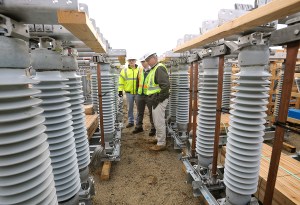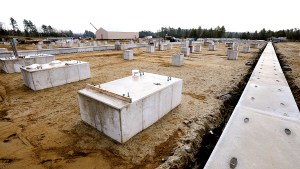LEWISTON — Some time in March, Central Maine Power crews and contractors will deliver a million-pound transformer to Lewiston, right about at the midpoint of the company’s Larrabee Road substation project.
“We’re not sure what route we’ll follow bringing it in,” said Chris Marshall, public involvement specialist for contracting firm Burns and McDonnell. “That’s still several weeks away.”
The company will use a specially designed 30-axle tractor-trailer to slowly carry the transformer from the coast, crawling along Maine’s roads and highways to Lewiston.
“It’s amazing to see,” Marshall said. “The trailer is articulated and each axle turns, so it just kind of spiders around the corners.”
Once it’s at the site, crews will use a series of cranes and trucks to lift it into place at the center of the lot at the dead end just off Lewiston’s Main Street — the crown jewel of the Larrabee Road project and the actual reason CMP is doing the work.
But wrestling the massive hunk of metal and oil into place in north Lewiston is only one stop in the project.
Crews have already dug up and removed 55,000 cubic yards of dirt from the 16-acre site and replaced it with 95,000 cubic yards of sturdier fill, getting it ready so that it can support the weight of the transformer and the surrounding substation.
They’re building an underground concrete structure to support both the transformer and the towers, some up to 125 feet tall, that will carry high voltage electricity in and out of the site.
They still have at least two more years of work to do once the transformer is in place, building the substation around it and connecting it to the grid that powers the northeastern United States.
“It’s part of the most massive construction program in Maine in years,” said John Carroll, public affairs manager for Central Maine Power.
More than 2,200 CMP employees, contractors and subcontractors are involved in the construction effort at any given time, he said.
The work in Lewiston is being duplicated in three other spots — in Benton, Windsor and Kennebunk. Monmouth, Cumberland and Elliot will get different substations, and eight other existing power substations across the state are being expanded to handle the higher voltage.
It’s all part of CMP’s $1.4 billion Maine Power Reliability Program. It calls for upgrading a swath of power lines, beginning in Eliot and passing through central Maine to Orrington, where they connect to lines from Canada. Along the way, they pass through Litchfield, Monmouth, Leeds, Greene, Lewiston and a corner of Auburn at the Durham line.
Carroll calls it a program, not a project, because it’s so much bigger than any single upgrade. It is four years’ worth of construction, erecting 442 miles of transmission lines across 75 Maine cities and towns. The entire program should be finished by 2015, with work in Lewiston wrapping in 2014.
“I think we can honestly say that nobody has tackled a project this massive in Maine, or in New England, in the last 40 years or so,” Carroll said. “So this is a one-of-a-kind project. CMP doesn’t have anyone who worked on anything similar. And we don’t plan on having to do it again for another 40 years.”
The current power grid dates back to 1971 and the Big 11 power loop designed and built in the wake of the 1965 Northeast blackout. Blamed on mistakenly set equipment at Niagara Falls, the outage included Maine, upstate New York, parts of New Jersey and southeastern Canada.
“As one or two utilities failed, it cascaded throughout the whole region,” Carroll said. “That set off a process of saying ‘we can’t let that happen again.’ The utilities across New England got together and planned.”
The utilities began working on a bulk electronic grid in 1966 to unify New England, connecting five oil-based electricity generators and five nuclear power plants with 700 miles of 345 kilovolt, or kv, transmission lines.
“It was a transmission backbone connecting all these plants,” he said.
The overall plan included a 345 kv transmission line built through western Maine, from Brownfield near the New Hampshire border northeast to Orrington. Maine users were connected to that line via a series of 115 kv transmission wires.
“The 345 kv lines are the top of the hierarchy,” Carroll said. “Think of them like roads. This is an interstate highway, and the 115 kv lines are like a local artery. So we’ve had one highway serving the entire state.”
It was sufficient until 2003, when the northeastern U.S. states and parts of Canada were hit by another massive blackout. That outage stretched from Michigan and Ohio north to Ontario and back to New Jersey.
“That started a whole other round of talks,” he said. “It spurred the Energy Policy Act of 2005, which was a federal response.”
Local utilities were no longer allowed have voluntary standards. A stronger grid became a matter of national security, with mandatory standards.
The new system is designed to add redundancy to the northeastern U.S. power grid, routing electricity around problem areas when necessary.
The Lewiston substation’s job will be to step down the extremely high voltage electricity traveling along the newly built 345 kv transmission line network, turning it into merely high-voltage 115 kv electricity suitable for delivery to customers in central Maine.
Smaller substations around the region will reduce the voltage again to 34,500 volts, sending it on to roadside transformers of 12,700 volts. The final steps are the gray columns hanging from the tops of wooden power poles in most neighborhoods. Those step electricity down from transmission standards to 240 volts, suitable for household use.
When they’re done, the Larrabee Road lot will look like an industrial orchard, with rows of towers rising out of the ground. The 345 kv lines will run through Larrabee Road, turning east and continuing on to Monmouth.
A series of 115 kv lines will branch off from Larrabee Road, carrying electricity to Rumford in the north and to areas west and south of Lewiston.
The electricity’s route through the Larrabee Road substation will be controlled by a series of switches and circuit breakers, which can be activated from a control panel on site or from the company’s main control in Augusta.
“It’s basically all automated controls and monitoring,” Carroll said. “They might tell switches to open or close, diverting power from one location to another.”
The entire facility will be surrounded by a security fence. Once they’re done, Carroll said, the construction crews and most of the excitement will go away.
“We worked with one of the local snowmobile clubs, because they had a trail that went right through the middle here,” he said.
That trail is now located up on the hill, overlooking the site.
“We couldn’t have them going through the middle of a construction site,” Carroll said. “When we’re done, they won’t know we’re here.”


Comments are no longer available on this story